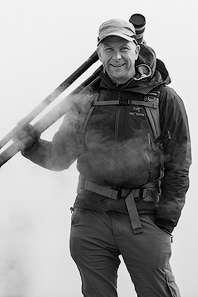I grew up backpacking in the California Sierra and Oregon Cascades with my family and have continued to explore the back country and high mountain wilderness ever since. In my twenties and thirties I spent most of my time in the wilderness climbing, carrying ridiculously heavy packs and taking the most direct path to whatever summit was close by. These days I prefer to take more leisurely trips into the wilderness to photograph mountains instead of climbing them. My most rewarding outdoor experiences come from spending a few days with the camera, far away from more crowded roadside landscapes. When I first began going into the wilderness to photograph I simply traded out my climbing gear for camera gear, convinced that a heavy pack was the hallmark of a burly woodsman. Now that I have both hiking boots planted firmly in middle age I find that carrying too much weight has become painful, demoralizing and potentially injury inducing.
In the past few years I have made it a priority to lighten my backpack so I can get up in the hills with a minimum of suffering and maximum of comfort and mobility. It is a work in progress, but I now have a set-up that seems to be working well for me. I figured some people would be interested to know what my back country kit is composed of and that was the motivation for this article. Fellow PhotoCascadian, David Cobb, also an avid back country photographer, previously wrote an article detailing his lightweight backpacking set up. Most of my gear choices are based on suggestions from friends and some basic Internet research and comparison. I don’t have any personal or financial stake in the companies or gear on my list. I genuinely like and endorse all the gear I’m using. However, there are many other options out there which would work equally well or even better.
My main goal is to keep my total fixed pack weight (not including clothes, food and water, which varies day by day and season by season) under 15-18 pounds.
Pack – I use an Osprey pack that is closest to the current Xenith 75 Model: 5.4 lbs. This is the one place where I am willing to go a little heavier for better comfort and load distribution. I find that a good pack can make a heavy load feel lighter than it would with a less able but lighter pack.
Tent – Big Agnes Copper Spur UL1 : 2.5 lbs. Super roomy single person for the weight and very weather proof for a three season tent. I love the big side entry door and high ceiling.
Sleeping bag -Three season – Mountain Hardwear Phantom 45: 1.2 lbs. Good for me down to about 35 degrees F. Cold weather – Marmot Helium: 2.4 lbs. Good for temps down into the low teens or even colder if I wear layers. Both of these down bags are super comfy and light.
Pad – Big Agnes Q-Core SL: 1.1 lbs. I’m getting older and stiffer so the 3.5 inches of air cushion really helps me get a good night’s rest. It also keeps me warm down into the low teens.
Stove – MSR Pocket Rocket: 0.2 lbs. Super light, super small, super fast, super reliable.
Kitchen Kit – MSR Quick Solo Pot: .5 lbs. It’s a pot.
Water treatment – Katadyn Hiker: 0.75 lbs. Basic and reliable, although not the lightest out there.
This puts my basic kit at 11.65 or 12.85 lbs depending on which sleeping bag I take. I have another couple of pounds of odds and ends like first aid kit, head lamp, 10 essentials kit, fuel, mug, etc. That brings me up to about 15 pounds total. This leaves about 20 pounds for extra clothing layers, food and camera gear to stay under my 35 pound limit. For camera gear I choose from the following options.
Camera – Canon EOS 5D mark III or Sony NEX-7
Lenses – 24-105mm or similar. 16-35mm and/or 70-200mm if essential.
Tripod – MeFoto Road Trip or Gitzo Mountaineer.
Camera clip – Peak Design Capture Pro Camera Clip. I hike with my camera outside my pack so I’m ready to shoot at any time without needing to take off the pack and unload it. I find the Peak Design clip an excellent way to carry the camera outside the pack in easy reach.
Depending on how light I want to go will determine which camera, tripod and lenses I take. For the most lightweight rig I’ll take the Sony NEX-7, single 16-55mm lens (roughly 24-82mm equivalent) and the MeFoto Road Trip tripod.

Sean is an outdoor photographer, digital image developing enthusiast and photography educator based in Ashland, Oregon, where he resides with his wife and two sons. His previous career as a science teacher makes photography education a good fit. Sean teams up with fellow Photo Cascadia members leading workshops. He also teaches digital image developing classes, lectures and offers a series of Photoshop video tutorials.
More posts by Sean Visit Sean’s Image Gallery Visit Sean’s Website




Recent Comments